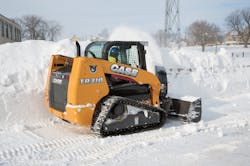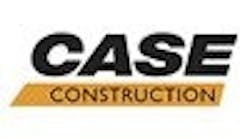Reprinted with the permission of Equipment Manager magazine, the magazine of the Association of Equipment Management Professionals.
Getting every billable hour out of a machine is the battle cry of all fleet managers. With that, we’re now asking for more out of our equipment than ever before. Longer hours. Longer seasons. A broader set of applications and demands. Simultaneously, emissions technology has introduced new components and materials to the maintenance equation. It’s becoming more critical for each side of the Equipment Triangle—end user, manufacturer and distributor—to work together to ensure optimal uptime and performance. This is especially true in the winter months, when freezing temperatures fundamentally change how fluids and systems operate.
Added measures will keep equipment running in peak condition throughout winter, but remember to always consult the owner’s manual and the local dealer with any questions and/or before making any significant changes to regular maintenance practices.
Equipped for success
Equipment owners who work in northern climates can include a cold-weather package at purchase of a new machine. This package will vary from machine to machine and OEM to OEM, but the general idea is the same: Optional equipment is provided, addressing some of the most vital pain points of winter operation.
A cold-weather package on a wheel loader, for instance, can protect machines working in extreme temperatures down to minus 50 F. One such package offers two heavy-duty 950 CCA 12V batteries, low-temperature hydraulic oil, a hydraulic oil cooler bypass, hydraulic heat load valve, an engine block heater, an air-intake grid heater and fuel warmer, heated mirrors, and a reversing fan to remove snow accumulation from the radiator.
Greater consideration to auxiliary hydraulics should also be given for those who may transition their equipment to snow-removal applications in winter. Skid steers, for instance, with optional high-flow and enhanced high-flow hydraulics will provide more effective attachment use and a broader range of available attachments.
A cab-activated quick coupler will allow the operator to easily switch between buckets and other attachments without having to leave the comfort of the cab and having to work with chains and binders.
Equipment owners may also want to consult with their dealers on the optimal tires and tracks for their application. Added lighting packages are also available and are especially important for improved visibility and safety. Telematics should also be considered: Equipment is operating under a whole different set of strains in cold weather and tends to be placed/parked across a broad geographical area. It’s important to monitor utilization and performance to identify any abnormalities that may be symptomatic of larger issues, as well as hours of use worked toward scheduled maintenance.
Fluid considerations
Freezing temperatures are the sworn enemy of fluids. Some freeze, some gel—almost all affect the way the fluid works within the machine. Fleet managers must take care to use proper fluids during the winter months, and operators must always go through proper warm-up procedures before operating. These are outlined in the operator’s manual for each machine, and a few specific points are detailed in the following sections.
Warm-up periods are mandatory but will vary from machine to machine. The warm-up allows the machine to attain 100 percent functionality faster, and will help prevent damage and/or inefficient operation caused by cold fluids and components. For machines outfitted with grid heaters, always first turn the key to “on” and wait until the grid heater lamp turns off before cranking the engine. Once it’s started, operators should run the engine at about half throttle for a few minutes under no load. Then, depending on the machine, the operator should perform a number of actions to manipulate the bucket and boom. This effectively pushes warm hydraulic oil out into the system and brings colder oil back into the core of the machine to warm. Circulating over relief for a time, and then pushing that hydraulic oil out into the system, can further expedite warming. All operators should be familiar with the proper warm-up procedure for each machine.
Extremely low-temperature operation requires the use of a synthetic or blended winter oil with a lower viscosity determined by how low the average temperature reaches. Thick oil takes longer to move to the top of the engine and ultimately requires the whole system to work harder than it needs to. O-rings can blow off of oil filters due to the combination of cold weather and the wrong oil. A standard 15W-40 should be sufficient if the weather never falls below 14 F. A 10W-40 is fine down to minus 4 F, and a 0W-40 can be used down to minus 22 F. Each owner’s manual provides a chart for suitable engine oil based on temperatures.
Winter oil can be used year round, but “summer oil” should not be used at those lower temps. Plan accordingly.
Construction equipment is designed to run on No. 2 off-road diesel, but a winter blend (combination of No. 1 and No. 2) should be used in the winter months to ensure proper lubrication qualities and to reduce gelling. Equipment owners should identify a trusted supplier of quality diesel, and one that has a high turnover of fuel to ensure the product isn’t stale.
Operators should also top off their tank each day after use to prevent the opportunity for condensation. Always clear away snow and other possible contaminants from around the fill point before fueling. Water should also be drained from the pre-filter and tank on a daily basis.
Most common hydraulic oils are suitable down to 0 F, but a synthetic is recommended for those applications where temperatures drop below zero. It is critical to cycle hydraulics before operating. Cold fluid is thicker and creates more pressure, and cold hoses are more brittle. A deliberate warming sequence performed each day will alleviate these issues.
DEF and emission systems
Diesel exhaust fluid (DEF) will freeze at 12 F. This will not cause any problems as long as the machine has an internal tank heater. Where this does come into play is during the shutdown procedure. Each machine that requires DEF has an automatic function that evacuates it from the distribution lines. A light or an audible noise indicates DEF is still pumping back into its reservoir, meaning the machine should not be turned off and the battery should not be disconnected until after this process is complete.
Like all fluids, DEF is susceptible to contamination and should be handled properly, with minimal exposure to outside elements (a closed handling system is recommended). Some storage and dispensing solutions provide heating elements that keep it thawed. DEF is a specific blend of urea and deionized water—anti-gelling or freeze point improvers should not be added. Any blending or adjustment to the mixture will lessen its ability to perform correctly and may cause damage to the emissions components.
Additionally, idling the machine to maintain operating temperature can have increased adverse effects on the equipment and operating system. Idling machines with emissions systems can have a detrimental effect for those that use diesel particulate filters. These filters will collect particulate matter more quickly, requiring regeneration more often, which can negatively impact productivity and fuel consumption when the machine is called back into action. Always double-check the recommended coolant type as well as the current coolant in use. Many Tier 4 Final machines require extended-life coolant, or organic acid technology (OAT), and mixing of OAT with traditional or conventional coolants will lead to gelling. OAT is backward-compatible on older machines, but those systems must be flushed three times before OAT is used.
The cold steel of a machine goes through freeze/thaw cycles. A strict greasing regimen is required in winter to not only keep the moving parts lubricated, but to keep out dirt and moisture that can lead to rusting, seizing or other problems.
Electrical system maintenance
There is arguably no time of year that puts more strain on a machine’s electrical system than winter with its need for heaters, wipers and continuously running lights. Drained batteries work harder to crank the engine. Preseason maintenance is critical, and fleet managers should consider working with their dealer on a preseason checkup of the electrical system to ensure optimal performance. Fleet managers should also check the alternator belt and the rated current output of the alternator.
Special attention should be given to batteries. Clean the battery and its connections, and make sure it is at full charge. A fully charged battery at 1.4 F has only 40 percent of its normal starting power, and a battery at minus 20.2 F only has 18 percent. In cold conditions, it is critical to run the machine long enough to return the charge lost by starting. That may be as short as 10 minutes, but it may take up to 30 minutes in extreme cold temperatures.
A second battery kept on hand in case of a dead battery can help further ensure cold-weather performance. It is best to connect a battery to a maintainer to keep it at a full state of charge any time the battery will be sitting for an extended period. When possible, a machine should always be parked indoors to further mitigate these issues, but that is not always practical.
Today’s electrical systems are fully functioning computers. It is always a best practice to allow the electrical system on these newer machines to fully cycle down before using the master disconnect switch, ensuring that all systems have gone through proper shutdown and will be ready for the next startup. When using the battery master disconnect, always remember to also wait until the DEF line evacuation is complete.
Prepping the cab
It’s not only the machine that will be subject to the elements—there’s an operator that will be in that machine each day. Check all doors, panels and seals before the weather turns in order to ensure the cab is protected from the elements. Replace the wipers, clean the cab, replace the cab air filter, and make sure that the HVAC system is working properly. If the operator turned off the water circuit to the cab heater for better cooling in the summer, turn the heater back on in the winter to improve heating.
It’s also important to inspect the exhaust system. In some machines, the exhaust is located near the cab intake. To prevent exhaust gases from being pulled into the cab, check for signs of a rotting pipe and/or blockage to the exhaust.
Cold weather affects pneumatic tires too. Check tires for proper inflation and any damage before winter operation. The cleaning and clearing of tires and tracks is even more important during this time of year: With all the snow, ice and moisture in the dirt, it becomes increasingly possible for the tires or tracks to freeze and bind. All of that moisture and dirt introduced into the working parts of an undercarriage can expedite wear and damage.
Replace any damaged glass and mirrors, and check and replace all work lights/beacons. Check all flashers, signals and brake lights, and ensure that the backup alarm is working. Also test and clean the backup camera.
As important as the preseason activities are, the daily pre- and post-operation inspections by the operator are even more important in winter. These inspections reveal any leaks, damage or other problems that can then be serviced before causing too much downtime. Operators should also check fluid levels, auxiliary hydraulic connections, belts, hoses, attachment connections, and the machine’s surroundings for any signs of damage. A daily walkaround by the operator, both pre- and post-operation, should be considered mandatory.
Andrew Dargatz is a brand marketing manager for Case Construction Equipment.






